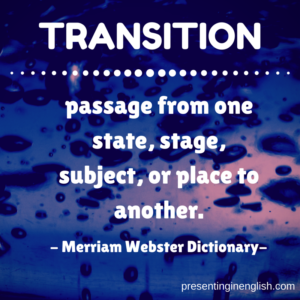
It is important, no matter how many points you have in your presentation, that you transition between each of those points clearly and smoothly. You need to let your audience know that you are moving on and changing the subject. This is why we use a transition device. Here are four ways to make it clear to the audience that you are changing points:
Words
This is probably the easiest and simplest way to transition. Just like you would do if you were writing an essay, you mark your transition with certain words. For example, ‘My next argument is…’, ‘I would like to close with…’ or ‘Thirdly…’ If you feel these standard transitions are too boring, here some examples of more exciting transitions ‘But then….’ , ‘That was all a lie, the truth is….’, or ‘What you may not know is…’
Also when speaking you may wish to also change the volume and/or pitch of your voice to further emphasise your transition.
Pause
Sometimes not speaking at all can be the most powerful transition. It gives the audience a chance to absorb what you have just said – especially if it was a powerful summary of your previous argument. When we are speaking a small pause can feel like an eternity to a speaker, but in reality it is just a few seconds for the audience. Feel free to count the seconds in your head to make sure you’ve given the audience enough of a pause. The bigger the change in subject, the bigger the pause can be.
Movement
For advanced speakers, in addition to pausing you can also add movement to show the transition. While you are pausing, walk slowly to another spot on the stage. This will visually emphasise that you are changing ideas. This technique can be especially helpful if you are giving information in a chronological order or telling a story. You can move gradually from one side of the stage to the other to show the passing of time.
Just be sure that you are speaking to all parts of the audience and you are not turning your back on the extreme right or left sections. In most cases it is best to come back to the centre of the stage to deliver a powerful conclusion. This way you are reaching members of the audience on both sides equally.
Visual
Are you using slides or some other sort of visual aid? Why not use that to make your transition. A shocking image, important statistic or interesting quote can be an interesting way to transition. Just make sure that after the audience sees the visual transition that you bring the attention of the audience back to you as the speaker.
TRANSITION: passage from one state, stage, subject, or place to another. – Merriam Webster Dictionary
